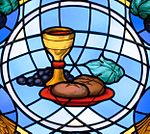| Part of a series on the |
| Eucharist |
|---|
 |
The Holy Qurbana (Syriac: ܩܘܼܪܒܵܢܵܐ ܩܲܕܝܼܫܵܐ, Qurbānā Qaddišā in Eastern Syriac or Qurbānā Qandišā in the Indian variant of Eastern Syriac, the "Holy Offering" or "Holy Sacrifice" in English), refers to the Eucharistic liturgy as celebrated in Syriac Christianity and the liturgical books containing the rubrics for its celebration. Churches that celebrate this liturgy include various descendants of the Church of the East. East Syriac Christianity consists of an Edessan liturgical rite called the East Syriac Rite (also known as the Edessan Rite, Assyrian Rite, Babylonian Rite, Chaldean Rite or Persian Rite). The major anaphora of the East Syriac tradition is the Holy Qurbana of Saints Addai and Mari; Addai being a disciple of Thomas the Apostle and Mari being Addai's disciple. These churches are primarily based in the Middle East and India, with diasporic communities settled in the western world.
The East Syriac Rite is employed by the Assyrian Church of the East based in Iraq (including its archdiocese the Chaldean Syrian Church of India) and the Ancient Church of the East based in Iraq. Additionally, the rite is employed by the Syro-Malabar Church based in India and the Chaldean Catholic Church based in Iraq, both of which are sui iuris Eastern Catholic Churches.